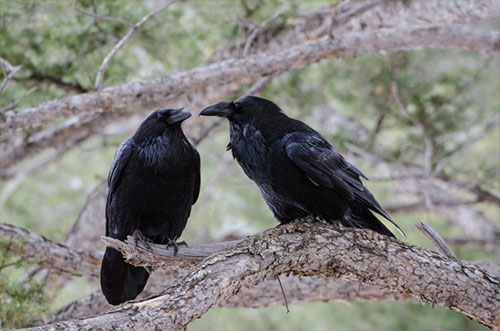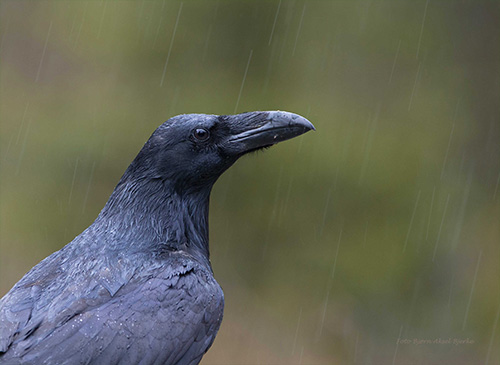
Two species of ravens nevermore?
|
||||
A pair of ravens. |
“We examined genomic data from hundreds of ravens collected across North America,” said Anna Kearns, the study’s first author and a former postdoctoral fellow at UMBC, who is now a postdoc at the Smithsonian Center for Conservation Genomics. “Integrating all of the results across so many individuals, and from such diverse datasets, has been one of the most challenging aspects of this study. Next-generation genomic techniques are revealing more and more examples of species with hybrid genomes.”
When Omland initially began work on this project in 1999, common ravens were considered a single species worldwide. He thought further research might uncover two distinct species — perhaps an “Old World” and “New World” raven — but the real story is much more complicated. Omland reported the existence of two common raven lineages in 2000, one concentrated in the southwestern United States dubbed “California,” and another found everywhere else (including Maine, Alaska, Norway and Russia) called “Holarctic.”
Since then, the plot has thickened. Two undergraduates in Omland’s lab, Jin Kim and Hayley Richardson, analyzed mitochondrial DNA from throughout the western United States and found the two lineages are extensively intermixed. In 2012, the Norwegian Research Council provided major funding for the project and Kearns spent a year at the University of Oslo analyzing nuclear genome data.
The best explanation based on the team’s analysis is that the California and Holarctic lineages diverged for between one and two million years, but now have come back together and have been hybridizing for at least tens of thousands of years.
A raven in the rain. |
“It is fascinating to me that this complex history of raven speciation has been revealed. For decades my students and I held and studied ravens throughout the West and never once suspected they carried evidence of a complex past,” said co-author John Marzluff, professor of wildlife science at the University of Washington. “Thanks to collaborations among field workers and geneticists, we now understand that the raven is anything but common.”
How does this relate to people? Humans are also a product of speciation reversal, Omland notes, with the present-day human genome including significant chunks of genetic material from Neanderthals and Denisovans, another less well-known hominid lineage. Recent genetic studies have even indicated a mysterious fourth group of early humans who also left some DNA in our genomes.
“Because speciation reversal is a big part of our own history,” Omland said, “getting a better understanding of how that happens should give us a better sense of who we are and where we came from. These are existential questions, but they are also medically relevant as well.”
Next steps in the current avian research include analyzing genetic data from ravens who lived in the early 1900s to investigate the potential role of humans in the speciation reversal process. “Getting genomic data out of such old, degraded specimens is challenging,” Kearns said, “and all work must be done in a special ‘ancient DNA’ lab at the Smithsonian’s Center for Conservation Genomics.”
If those ravens have a similar distribution of genes from the Holarctic and California lineages as the ravens living today, it’s unlikely changes in human civilization over the last century played a role.
On the Web:
Nature Communications volume 9, Article number: 906(2018): Study Genomic evidence of speciation reversal in ravens
Editing by Mary Kauffman, SitNews
Source of News:
University of Washington
www.washington.edu
Representations of fact and opinions in comments posted are solely those of the individual posters and do not represent the opinions of Sitnews.
SitNews ©2018
Stories In The News
Ketchikan, Alaska
Articles & photographs that appear in SitNews may be protected by copyright and may not be reprinted without written permission from and payment of any required fees to the proper sources.
E-mail your news & photos to editor@sitnews.us
Photographers choosing to submit photographs for publication to SitNews are in doing so granting their permission for publication and for archiving. SitNews does not sell photographs. All requests for purchasing a photograph will be emailed to the photographer.

